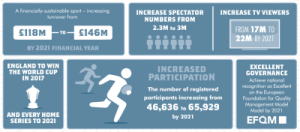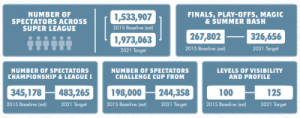The Rugby Football League has unveiled its seven-year strategic plan

The governing body is also hoping that it can improve the financial fortunes of Super League clubs in the process as it has set a target of having as many as nine clubs in profit by 2021 and ensuring that the average club's annual losses are cut to £100,000.
The average Super League club is currently losing £627,000 per year and just three clubs made a profit in 2014 but RFL chief executive Nigel Wood is confident that the ambitious aims can be met and says the sport is "perfectly placed" to take a big step forward in the coming years.
"The Rugby League World Cup, hosted by the RFL in 2013, demonstrated that off the field the RFL can successfully organise and promote truly world class events," he said.
"There are other reasons for confidence. The sport has a long-term contract with excellent broadcasting partners which will showcase the best our domestic competitions can provide, while providing the professional game with the financial stability to plan safely for the long term.
"The sport has embraced the new 'whole game' philosophy espoused in the 2013 Policy Review, restoring promotion and relegation and providing a canvass for collegiate and collaborative co-operation from all areas of the sport including the vibrant community game.
"There can, however, be no complacency. We must remain focused on ensuring that the prizes we believe the sport can attain, with its new competition structure, deliver as promised."
The RFL expects Super League Europe Ltd's turnover to rise from £27.7 million to £34.3 million by 2021 and professional and semi-professional club turnover to increase from £75 million to £90 million, whilst it wants to increase commercial revenues by 180 per cent from £2.5 million to £7 million and it thinks its own turnover should rise from £15.5 million to £22.3 million.

"An enhanced portfolio of commercial partners that cover all key consumer markets and categories will be acquired."
The overall vision is for Super League to become the premier sports league in the summertime in the UK and to "unite clubs, sponsors, broadcasters, stakeholders and staff in a common purpose" but some more specific short-term targets have been set as well.
The RFL is targeting a five per cent increase in total Super League attendances every year from 2015 onwards so that a total of 1,973,063 people come through the turnstiles in 2021 as opposed to 1,533,907 today. The overall attendance for Super League matches fell by five per cent in the 2014 season though.
The governing body wants to see the overall number of spectators for rugby league increased from 2,344,887 to 3,027,342 by 2021, with similar increases expected in the play-offs, Magic Weekend, Championship, League 1 and Challenge Cup.

"A specific programme through public relations, media and sales activity addressing the corporate level consumers, government and media will be pursued to raise the profile of the competition," the plan also states.
"All marketing and PR activity will be of a standard that positions Super League as a competition with national and international appeal. This will be specifically targeted to improve the positive approval of Super League and the sport in general in the eyes of the public and key opinion formers."

The RFL has been bold with its commercial objectives as it enters its 'new era' and the slogan of 'every minute matters' will be just as applicable off the field as on it as it strives to achieve them in the months and years to come.
Article written by Tim Groves
Article kindly provided by http://www.runningrugby.com/
